Mental Health Stigma and Treatment
VerifiedAdded on 2021/04/24
|9
|2711
|120
AI Summary
This assignment delves into the critical issues surrounding mental health stigma, including barriers to treatment, societal stigma, and internalized stigma. It also touches upon the importance of social support, patient activation, and recovery attitudes in overcoming these challenges. The references provided include a mix of academic articles and books that offer insights into community mental health, transactional analysis, and interventions targeting mental health self-stigma.
Contribute Materials
Your contribution can guide someone’s learning journey. Share your
documents today.
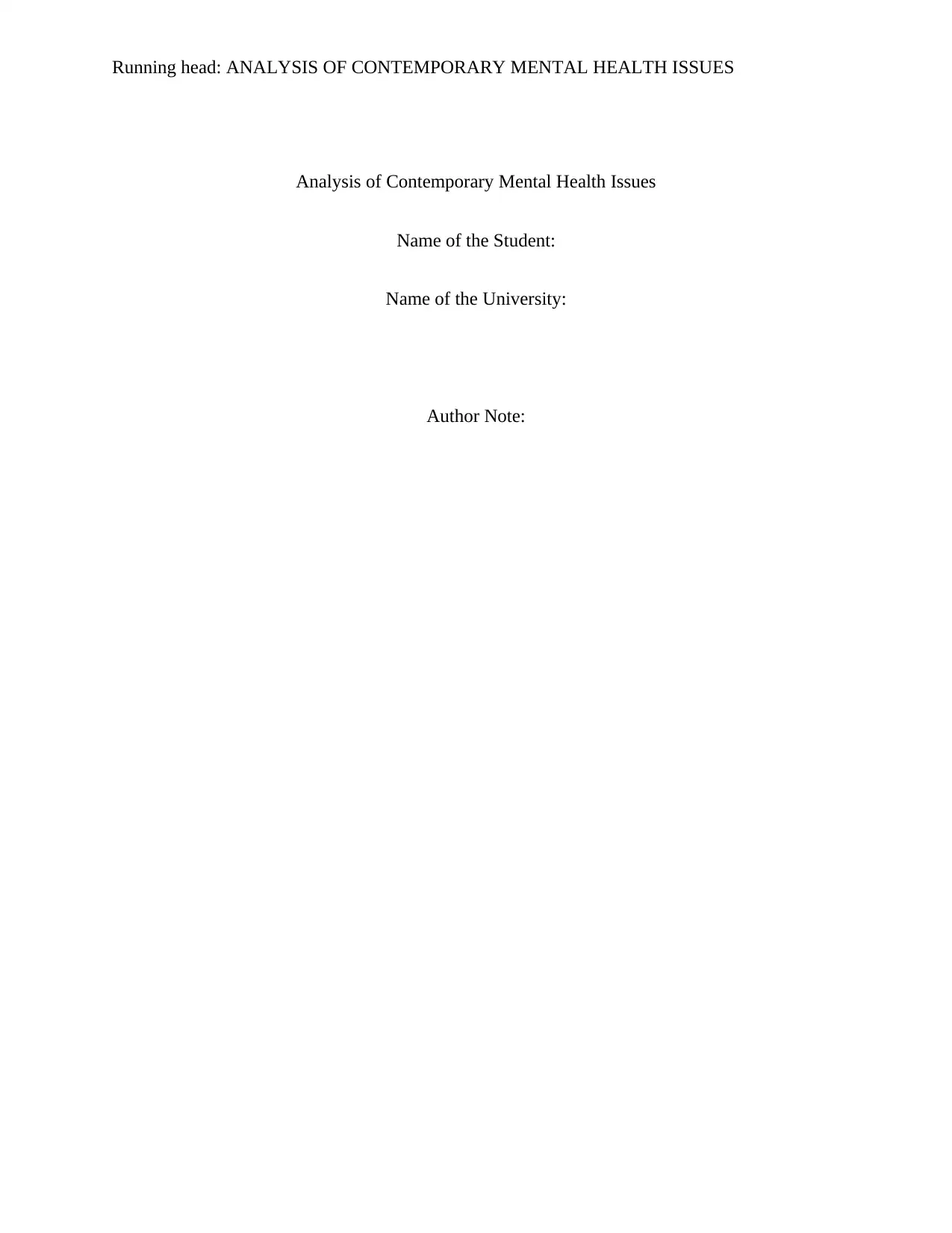
Running head: ANALYSIS OF CONTEMPORARY MENTAL HEALTH ISSUES
Analysis of Contemporary Mental Health Issues
Name of the Student:
Name of the University:
Author Note:
Analysis of Contemporary Mental Health Issues
Name of the Student:
Name of the University:
Author Note:
Secure Best Marks with AI Grader
Need help grading? Try our AI Grader for instant feedback on your assignments.
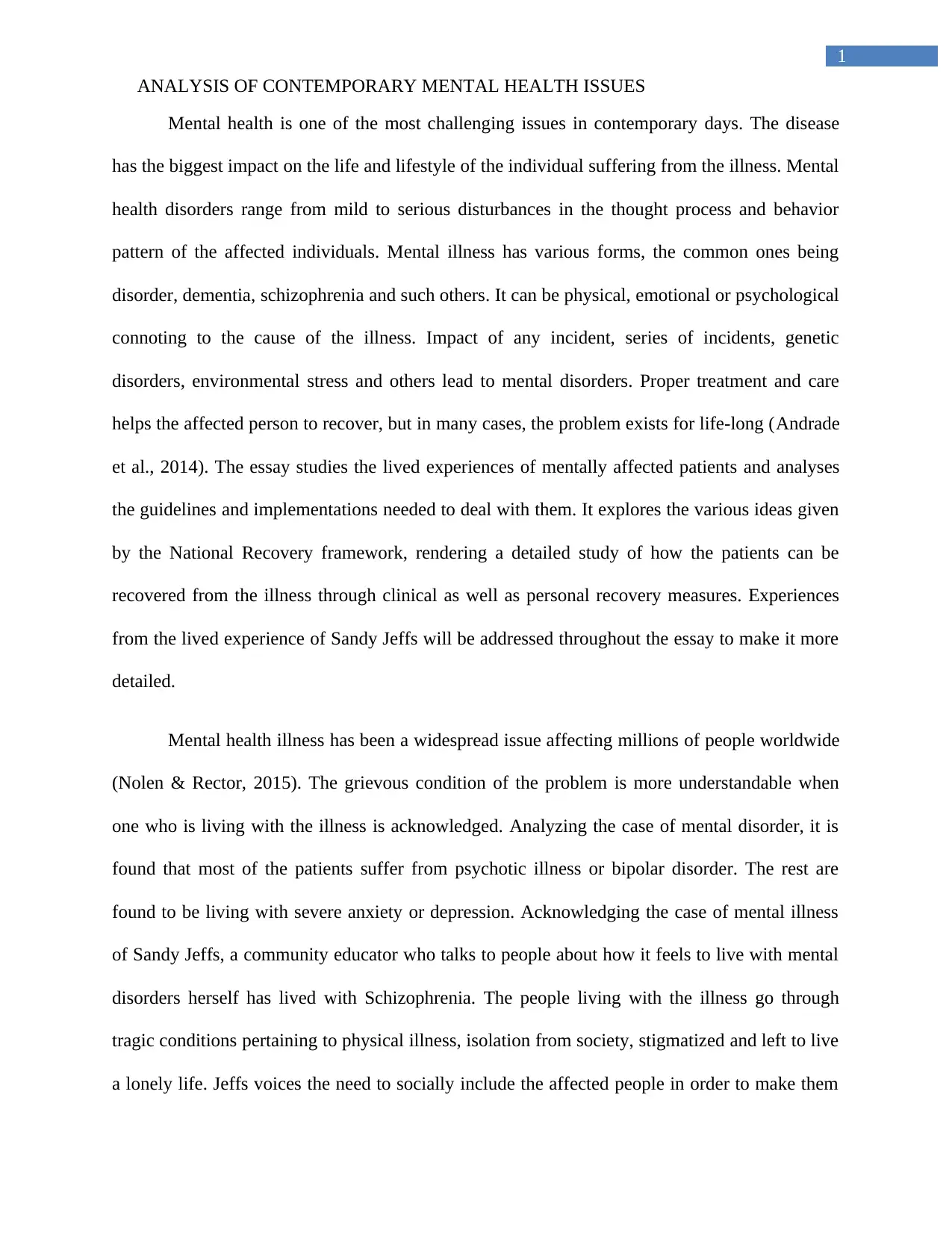
1
ANALYSIS OF CONTEMPORARY MENTAL HEALTH ISSUES
Mental health is one of the most challenging issues in contemporary days. The disease
has the biggest impact on the life and lifestyle of the individual suffering from the illness. Mental
health disorders range from mild to serious disturbances in the thought process and behavior
pattern of the affected individuals. Mental illness has various forms, the common ones being
disorder, dementia, schizophrenia and such others. It can be physical, emotional or psychological
connoting to the cause of the illness. Impact of any incident, series of incidents, genetic
disorders, environmental stress and others lead to mental disorders. Proper treatment and care
helps the affected person to recover, but in many cases, the problem exists for life-long (Andrade
et al., 2014). The essay studies the lived experiences of mentally affected patients and analyses
the guidelines and implementations needed to deal with them. It explores the various ideas given
by the National Recovery framework, rendering a detailed study of how the patients can be
recovered from the illness through clinical as well as personal recovery measures. Experiences
from the lived experience of Sandy Jeffs will be addressed throughout the essay to make it more
detailed.
Mental health illness has been a widespread issue affecting millions of people worldwide
(Nolen & Rector, 2015). The grievous condition of the problem is more understandable when
one who is living with the illness is acknowledged. Analyzing the case of mental disorder, it is
found that most of the patients suffer from psychotic illness or bipolar disorder. The rest are
found to be living with severe anxiety or depression. Acknowledging the case of mental illness
of Sandy Jeffs, a community educator who talks to people about how it feels to live with mental
disorders herself has lived with Schizophrenia. The people living with the illness go through
tragic conditions pertaining to physical illness, isolation from society, stigmatized and left to live
a lonely life. Jeffs voices the need to socially include the affected people in order to make them
ANALYSIS OF CONTEMPORARY MENTAL HEALTH ISSUES
Mental health is one of the most challenging issues in contemporary days. The disease
has the biggest impact on the life and lifestyle of the individual suffering from the illness. Mental
health disorders range from mild to serious disturbances in the thought process and behavior
pattern of the affected individuals. Mental illness has various forms, the common ones being
disorder, dementia, schizophrenia and such others. It can be physical, emotional or psychological
connoting to the cause of the illness. Impact of any incident, series of incidents, genetic
disorders, environmental stress and others lead to mental disorders. Proper treatment and care
helps the affected person to recover, but in many cases, the problem exists for life-long (Andrade
et al., 2014). The essay studies the lived experiences of mentally affected patients and analyses
the guidelines and implementations needed to deal with them. It explores the various ideas given
by the National Recovery framework, rendering a detailed study of how the patients can be
recovered from the illness through clinical as well as personal recovery measures. Experiences
from the lived experience of Sandy Jeffs will be addressed throughout the essay to make it more
detailed.
Mental health illness has been a widespread issue affecting millions of people worldwide
(Nolen & Rector, 2015). The grievous condition of the problem is more understandable when
one who is living with the illness is acknowledged. Analyzing the case of mental disorder, it is
found that most of the patients suffer from psychotic illness or bipolar disorder. The rest are
found to be living with severe anxiety or depression. Acknowledging the case of mental illness
of Sandy Jeffs, a community educator who talks to people about how it feels to live with mental
disorders herself has lived with Schizophrenia. The people living with the illness go through
tragic conditions pertaining to physical illness, isolation from society, stigmatized and left to live
a lonely life. Jeffs voices the need to socially include the affected people in order to make them
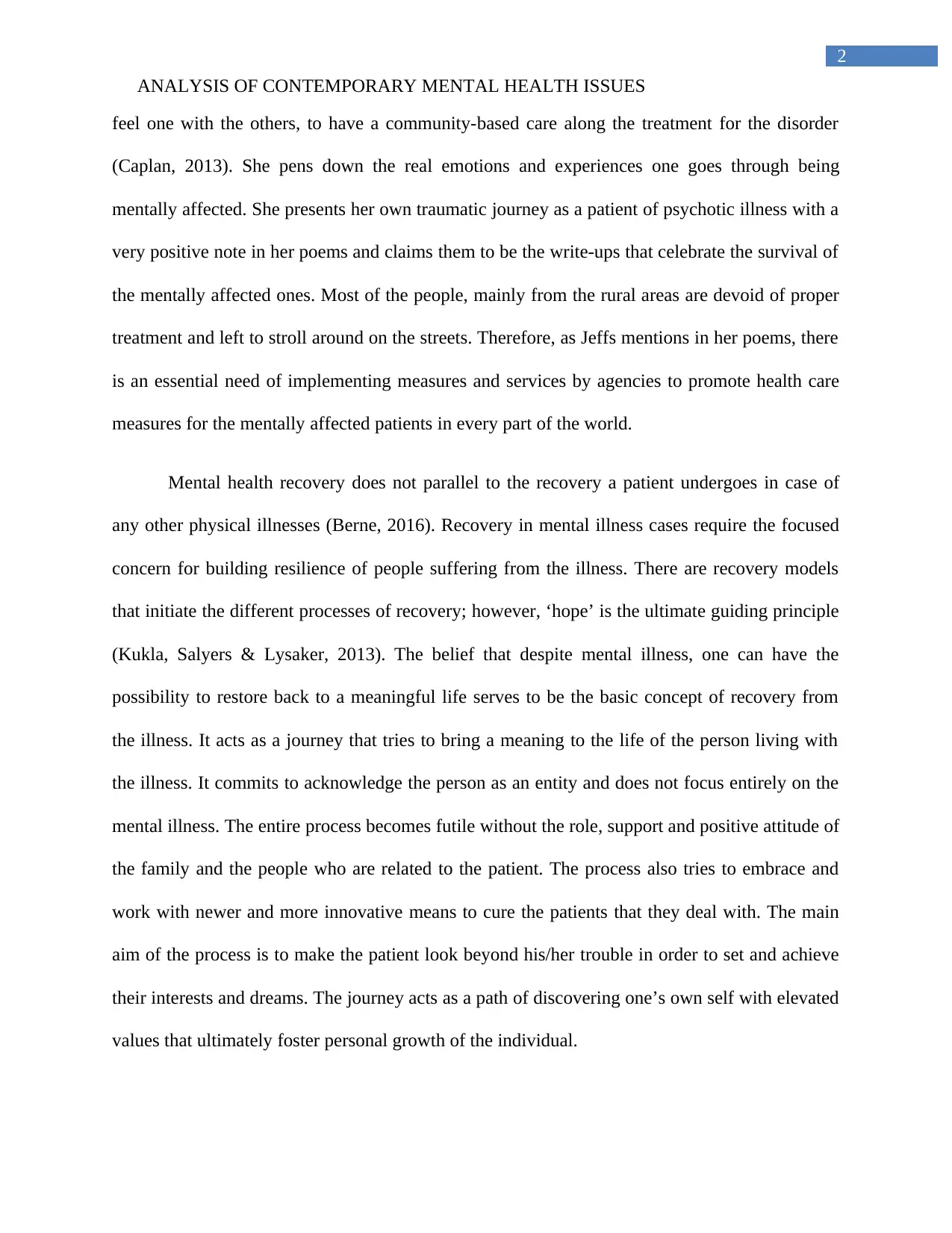
2
ANALYSIS OF CONTEMPORARY MENTAL HEALTH ISSUES
feel one with the others, to have a community-based care along the treatment for the disorder
(Caplan, 2013). She pens down the real emotions and experiences one goes through being
mentally affected. She presents her own traumatic journey as a patient of psychotic illness with a
very positive note in her poems and claims them to be the write-ups that celebrate the survival of
the mentally affected ones. Most of the people, mainly from the rural areas are devoid of proper
treatment and left to stroll around on the streets. Therefore, as Jeffs mentions in her poems, there
is an essential need of implementing measures and services by agencies to promote health care
measures for the mentally affected patients in every part of the world.
Mental health recovery does not parallel to the recovery a patient undergoes in case of
any other physical illnesses (Berne, 2016). Recovery in mental illness cases require the focused
concern for building resilience of people suffering from the illness. There are recovery models
that initiate the different processes of recovery; however, ‘hope’ is the ultimate guiding principle
(Kukla, Salyers & Lysaker, 2013). The belief that despite mental illness, one can have the
possibility to restore back to a meaningful life serves to be the basic concept of recovery from
the illness. It acts as a journey that tries to bring a meaning to the life of the person living with
the illness. It commits to acknowledge the person as an entity and does not focus entirely on the
mental illness. The entire process becomes futile without the role, support and positive attitude of
the family and the people who are related to the patient. The process also tries to embrace and
work with newer and more innovative means to cure the patients that they deal with. The main
aim of the process is to make the patient look beyond his/her trouble in order to set and achieve
their interests and dreams. The journey acts as a path of discovering one’s own self with elevated
values that ultimately foster personal growth of the individual.
ANALYSIS OF CONTEMPORARY MENTAL HEALTH ISSUES
feel one with the others, to have a community-based care along the treatment for the disorder
(Caplan, 2013). She pens down the real emotions and experiences one goes through being
mentally affected. She presents her own traumatic journey as a patient of psychotic illness with a
very positive note in her poems and claims them to be the write-ups that celebrate the survival of
the mentally affected ones. Most of the people, mainly from the rural areas are devoid of proper
treatment and left to stroll around on the streets. Therefore, as Jeffs mentions in her poems, there
is an essential need of implementing measures and services by agencies to promote health care
measures for the mentally affected patients in every part of the world.
Mental health recovery does not parallel to the recovery a patient undergoes in case of
any other physical illnesses (Berne, 2016). Recovery in mental illness cases require the focused
concern for building resilience of people suffering from the illness. There are recovery models
that initiate the different processes of recovery; however, ‘hope’ is the ultimate guiding principle
(Kukla, Salyers & Lysaker, 2013). The belief that despite mental illness, one can have the
possibility to restore back to a meaningful life serves to be the basic concept of recovery from
the illness. It acts as a journey that tries to bring a meaning to the life of the person living with
the illness. It commits to acknowledge the person as an entity and does not focus entirely on the
mental illness. The entire process becomes futile without the role, support and positive attitude of
the family and the people who are related to the patient. The process also tries to embrace and
work with newer and more innovative means to cure the patients that they deal with. The main
aim of the process is to make the patient look beyond his/her trouble in order to set and achieve
their interests and dreams. The journey acts as a path of discovering one’s own self with elevated
values that ultimately foster personal growth of the individual.
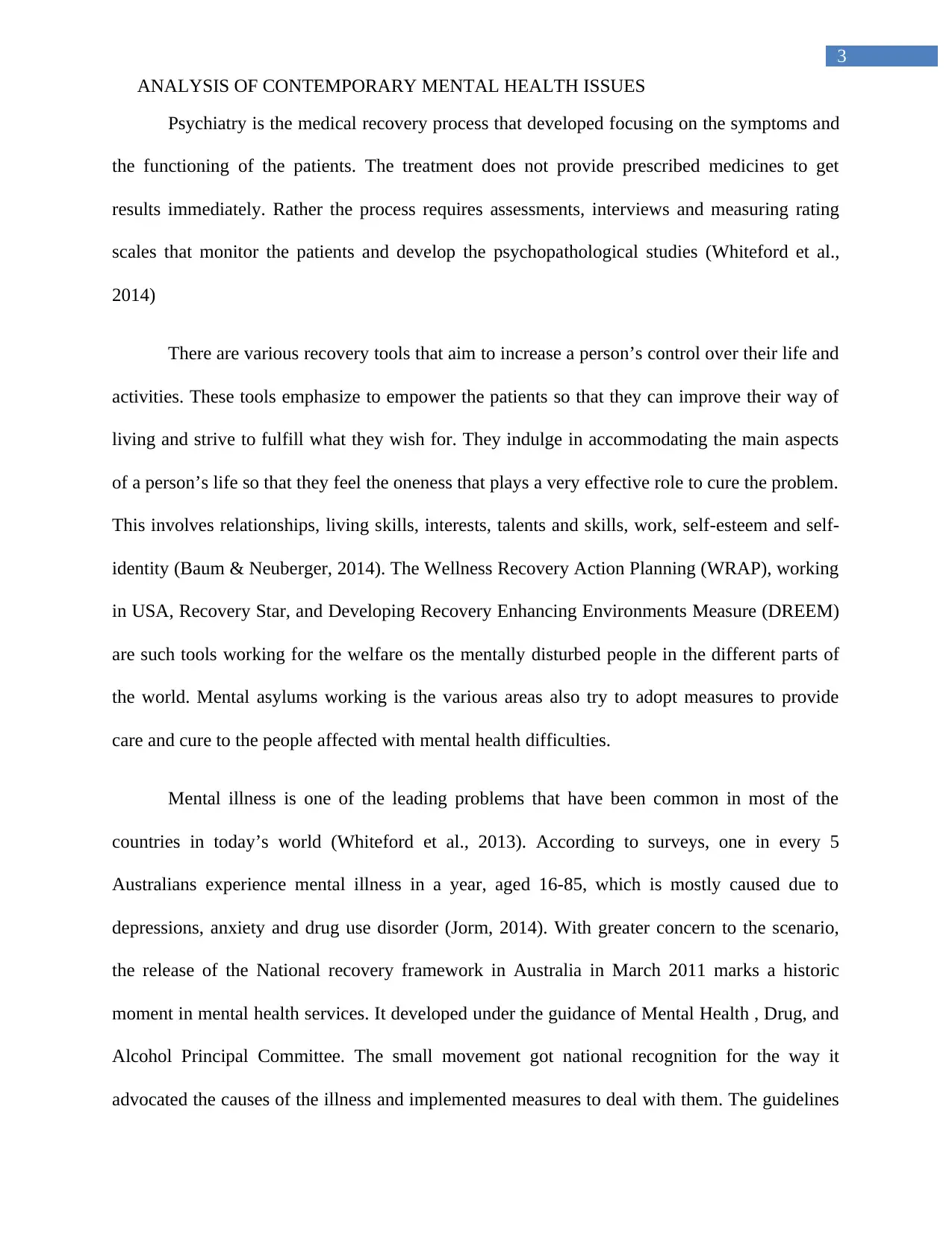
3
ANALYSIS OF CONTEMPORARY MENTAL HEALTH ISSUES
Psychiatry is the medical recovery process that developed focusing on the symptoms and
the functioning of the patients. The treatment does not provide prescribed medicines to get
results immediately. Rather the process requires assessments, interviews and measuring rating
scales that monitor the patients and develop the psychopathological studies (Whiteford et al.,
2014)
There are various recovery tools that aim to increase a person’s control over their life and
activities. These tools emphasize to empower the patients so that they can improve their way of
living and strive to fulfill what they wish for. They indulge in accommodating the main aspects
of a person’s life so that they feel the oneness that plays a very effective role to cure the problem.
This involves relationships, living skills, interests, talents and skills, work, self-esteem and self-
identity (Baum & Neuberger, 2014). The Wellness Recovery Action Planning (WRAP), working
in USA, Recovery Star, and Developing Recovery Enhancing Environments Measure (DREEM)
are such tools working for the welfare os the mentally disturbed people in the different parts of
the world. Mental asylums working is the various areas also try to adopt measures to provide
care and cure to the people affected with mental health difficulties.
Mental illness is one of the leading problems that have been common in most of the
countries in today’s world (Whiteford et al., 2013). According to surveys, one in every 5
Australians experience mental illness in a year, aged 16-85, which is mostly caused due to
depressions, anxiety and drug use disorder (Jorm, 2014). With greater concern to the scenario,
the release of the National recovery framework in Australia in March 2011 marks a historic
moment in mental health services. It developed under the guidance of Mental Health , Drug, and
Alcohol Principal Committee. The small movement got national recognition for the way it
advocated the causes of the illness and implemented measures to deal with them. The guidelines
ANALYSIS OF CONTEMPORARY MENTAL HEALTH ISSUES
Psychiatry is the medical recovery process that developed focusing on the symptoms and
the functioning of the patients. The treatment does not provide prescribed medicines to get
results immediately. Rather the process requires assessments, interviews and measuring rating
scales that monitor the patients and develop the psychopathological studies (Whiteford et al.,
2014)
There are various recovery tools that aim to increase a person’s control over their life and
activities. These tools emphasize to empower the patients so that they can improve their way of
living and strive to fulfill what they wish for. They indulge in accommodating the main aspects
of a person’s life so that they feel the oneness that plays a very effective role to cure the problem.
This involves relationships, living skills, interests, talents and skills, work, self-esteem and self-
identity (Baum & Neuberger, 2014). The Wellness Recovery Action Planning (WRAP), working
in USA, Recovery Star, and Developing Recovery Enhancing Environments Measure (DREEM)
are such tools working for the welfare os the mentally disturbed people in the different parts of
the world. Mental asylums working is the various areas also try to adopt measures to provide
care and cure to the people affected with mental health difficulties.
Mental illness is one of the leading problems that have been common in most of the
countries in today’s world (Whiteford et al., 2013). According to surveys, one in every 5
Australians experience mental illness in a year, aged 16-85, which is mostly caused due to
depressions, anxiety and drug use disorder (Jorm, 2014). With greater concern to the scenario,
the release of the National recovery framework in Australia in March 2011 marks a historic
moment in mental health services. It developed under the guidance of Mental Health , Drug, and
Alcohol Principal Committee. The small movement got national recognition for the way it
advocated the causes of the illness and implemented measures to deal with them. The guidelines
Secure Best Marks with AI Grader
Need help grading? Try our AI Grader for instant feedback on your assignments.
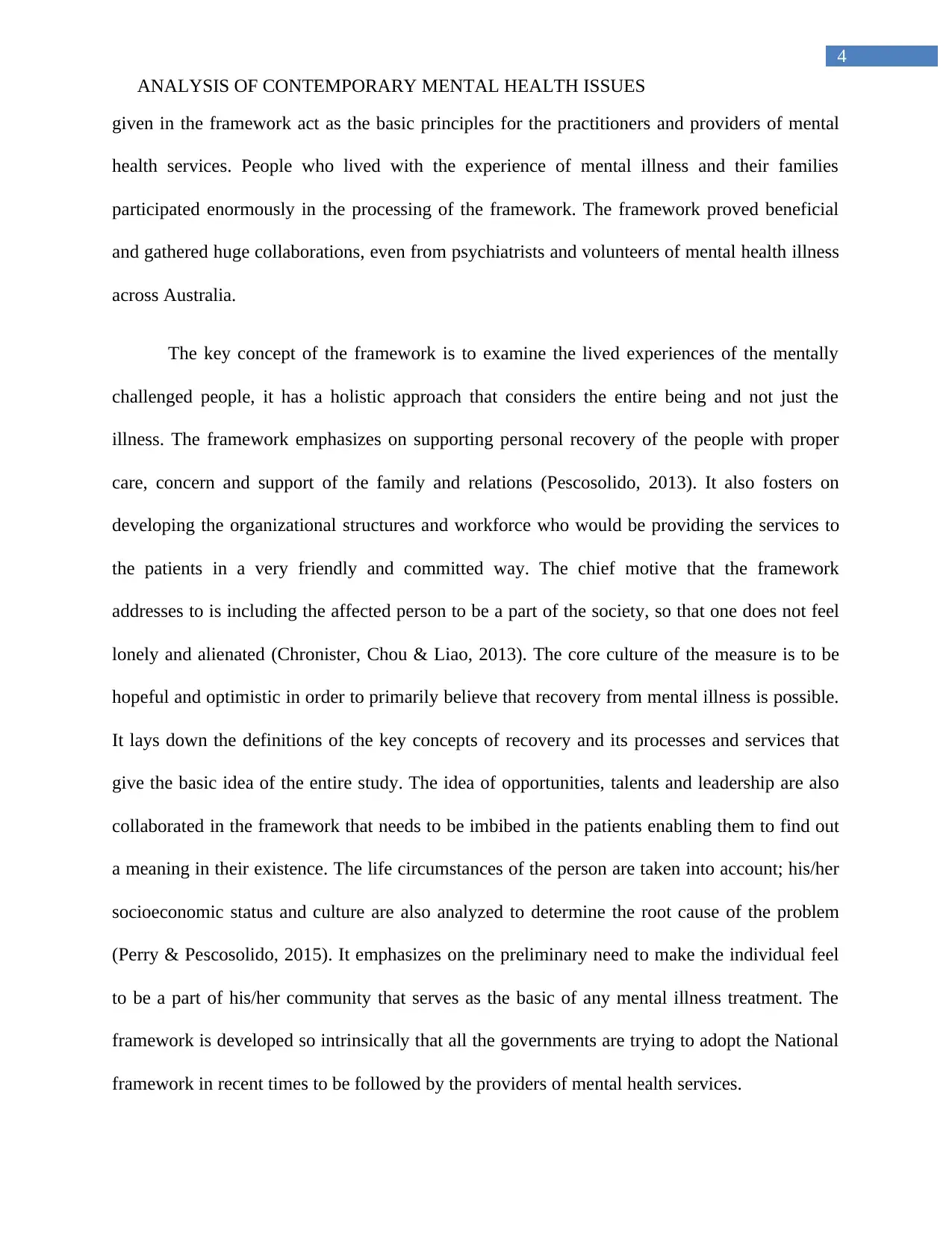
4
ANALYSIS OF CONTEMPORARY MENTAL HEALTH ISSUES
given in the framework act as the basic principles for the practitioners and providers of mental
health services. People who lived with the experience of mental illness and their families
participated enormously in the processing of the framework. The framework proved beneficial
and gathered huge collaborations, even from psychiatrists and volunteers of mental health illness
across Australia.
The key concept of the framework is to examine the lived experiences of the mentally
challenged people, it has a holistic approach that considers the entire being and not just the
illness. The framework emphasizes on supporting personal recovery of the people with proper
care, concern and support of the family and relations (Pescosolido, 2013). It also fosters on
developing the organizational structures and workforce who would be providing the services to
the patients in a very friendly and committed way. The chief motive that the framework
addresses to is including the affected person to be a part of the society, so that one does not feel
lonely and alienated (Chronister, Chou & Liao, 2013). The core culture of the measure is to be
hopeful and optimistic in order to primarily believe that recovery from mental illness is possible.
It lays down the definitions of the key concepts of recovery and its processes and services that
give the basic idea of the entire study. The idea of opportunities, talents and leadership are also
collaborated in the framework that needs to be imbibed in the patients enabling them to find out
a meaning in their existence. The life circumstances of the person are taken into account; his/her
socioeconomic status and culture are also analyzed to determine the root cause of the problem
(Perry & Pescosolido, 2015). It emphasizes on the preliminary need to make the individual feel
to be a part of his/her community that serves as the basic of any mental illness treatment. The
framework is developed so intrinsically that all the governments are trying to adopt the National
framework in recent times to be followed by the providers of mental health services.
ANALYSIS OF CONTEMPORARY MENTAL HEALTH ISSUES
given in the framework act as the basic principles for the practitioners and providers of mental
health services. People who lived with the experience of mental illness and their families
participated enormously in the processing of the framework. The framework proved beneficial
and gathered huge collaborations, even from psychiatrists and volunteers of mental health illness
across Australia.
The key concept of the framework is to examine the lived experiences of the mentally
challenged people, it has a holistic approach that considers the entire being and not just the
illness. The framework emphasizes on supporting personal recovery of the people with proper
care, concern and support of the family and relations (Pescosolido, 2013). It also fosters on
developing the organizational structures and workforce who would be providing the services to
the patients in a very friendly and committed way. The chief motive that the framework
addresses to is including the affected person to be a part of the society, so that one does not feel
lonely and alienated (Chronister, Chou & Liao, 2013). The core culture of the measure is to be
hopeful and optimistic in order to primarily believe that recovery from mental illness is possible.
It lays down the definitions of the key concepts of recovery and its processes and services that
give the basic idea of the entire study. The idea of opportunities, talents and leadership are also
collaborated in the framework that needs to be imbibed in the patients enabling them to find out
a meaning in their existence. The life circumstances of the person are taken into account; his/her
socioeconomic status and culture are also analyzed to determine the root cause of the problem
(Perry & Pescosolido, 2015). It emphasizes on the preliminary need to make the individual feel
to be a part of his/her community that serves as the basic of any mental illness treatment. The
framework is developed so intrinsically that all the governments are trying to adopt the National
framework in recent times to be followed by the providers of mental health services.
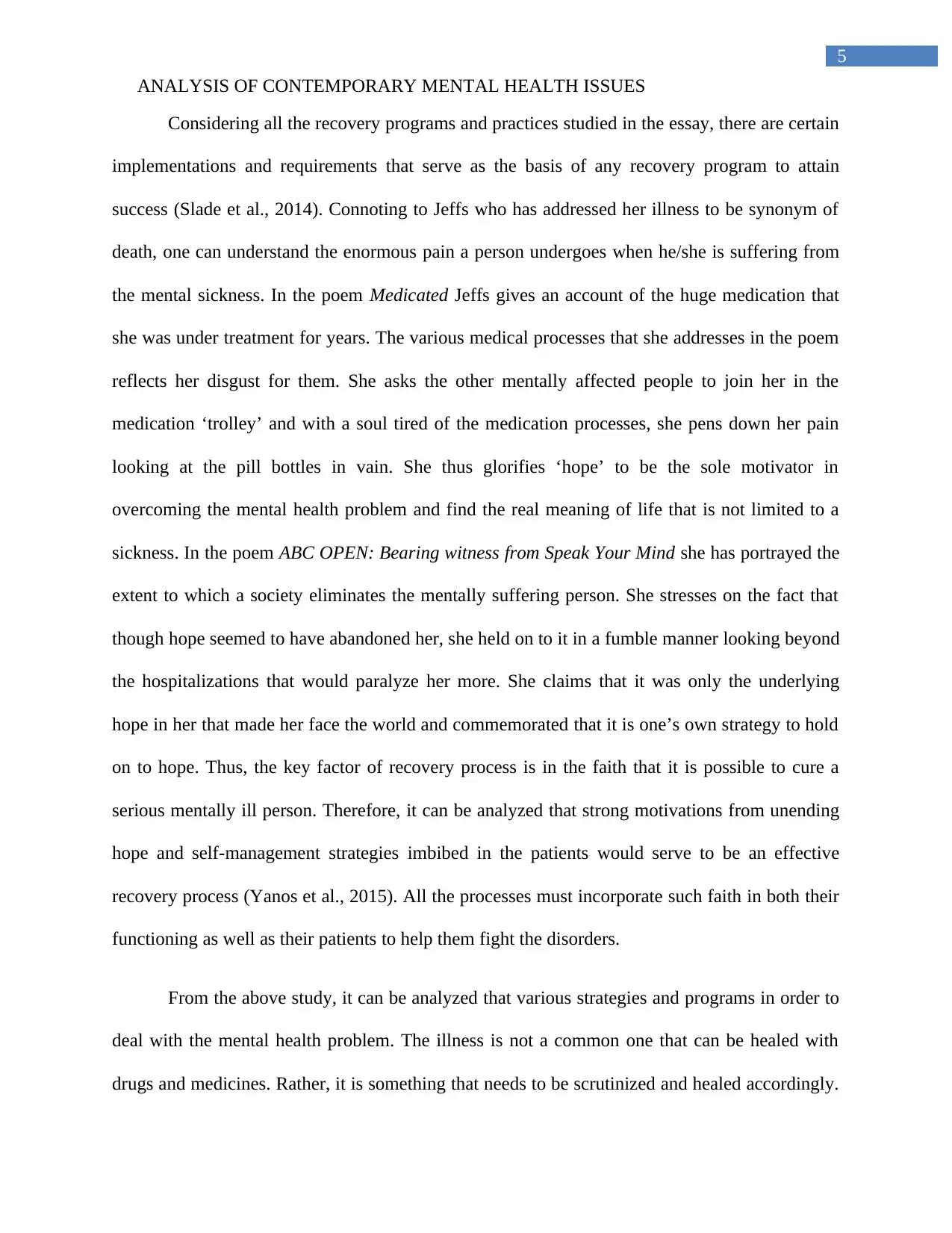
5
ANALYSIS OF CONTEMPORARY MENTAL HEALTH ISSUES
Considering all the recovery programs and practices studied in the essay, there are certain
implementations and requirements that serve as the basis of any recovery program to attain
success (Slade et al., 2014). Connoting to Jeffs who has addressed her illness to be synonym of
death, one can understand the enormous pain a person undergoes when he/she is suffering from
the mental sickness. In the poem Medicated Jeffs gives an account of the huge medication that
she was under treatment for years. The various medical processes that she addresses in the poem
reflects her disgust for them. She asks the other mentally affected people to join her in the
medication ‘trolley’ and with a soul tired of the medication processes, she pens down her pain
looking at the pill bottles in vain. She thus glorifies ‘hope’ to be the sole motivator in
overcoming the mental health problem and find the real meaning of life that is not limited to a
sickness. In the poem ABC OPEN: Bearing witness from Speak Your Mind she has portrayed the
extent to which a society eliminates the mentally suffering person. She stresses on the fact that
though hope seemed to have abandoned her, she held on to it in a fumble manner looking beyond
the hospitalizations that would paralyze her more. She claims that it was only the underlying
hope in her that made her face the world and commemorated that it is one’s own strategy to hold
on to hope. Thus, the key factor of recovery process is in the faith that it is possible to cure a
serious mentally ill person. Therefore, it can be analyzed that strong motivations from unending
hope and self-management strategies imbibed in the patients would serve to be an effective
recovery process (Yanos et al., 2015). All the processes must incorporate such faith in both their
functioning as well as their patients to help them fight the disorders.
From the above study, it can be analyzed that various strategies and programs in order to
deal with the mental health problem. The illness is not a common one that can be healed with
drugs and medicines. Rather, it is something that needs to be scrutinized and healed accordingly.
ANALYSIS OF CONTEMPORARY MENTAL HEALTH ISSUES
Considering all the recovery programs and practices studied in the essay, there are certain
implementations and requirements that serve as the basis of any recovery program to attain
success (Slade et al., 2014). Connoting to Jeffs who has addressed her illness to be synonym of
death, one can understand the enormous pain a person undergoes when he/she is suffering from
the mental sickness. In the poem Medicated Jeffs gives an account of the huge medication that
she was under treatment for years. The various medical processes that she addresses in the poem
reflects her disgust for them. She asks the other mentally affected people to join her in the
medication ‘trolley’ and with a soul tired of the medication processes, she pens down her pain
looking at the pill bottles in vain. She thus glorifies ‘hope’ to be the sole motivator in
overcoming the mental health problem and find the real meaning of life that is not limited to a
sickness. In the poem ABC OPEN: Bearing witness from Speak Your Mind she has portrayed the
extent to which a society eliminates the mentally suffering person. She stresses on the fact that
though hope seemed to have abandoned her, she held on to it in a fumble manner looking beyond
the hospitalizations that would paralyze her more. She claims that it was only the underlying
hope in her that made her face the world and commemorated that it is one’s own strategy to hold
on to hope. Thus, the key factor of recovery process is in the faith that it is possible to cure a
serious mentally ill person. Therefore, it can be analyzed that strong motivations from unending
hope and self-management strategies imbibed in the patients would serve to be an effective
recovery process (Yanos et al., 2015). All the processes must incorporate such faith in both their
functioning as well as their patients to help them fight the disorders.
From the above study, it can be analyzed that various strategies and programs in order to
deal with the mental health problem. The illness is not a common one that can be healed with
drugs and medicines. Rather, it is something that needs to be scrutinized and healed accordingly.
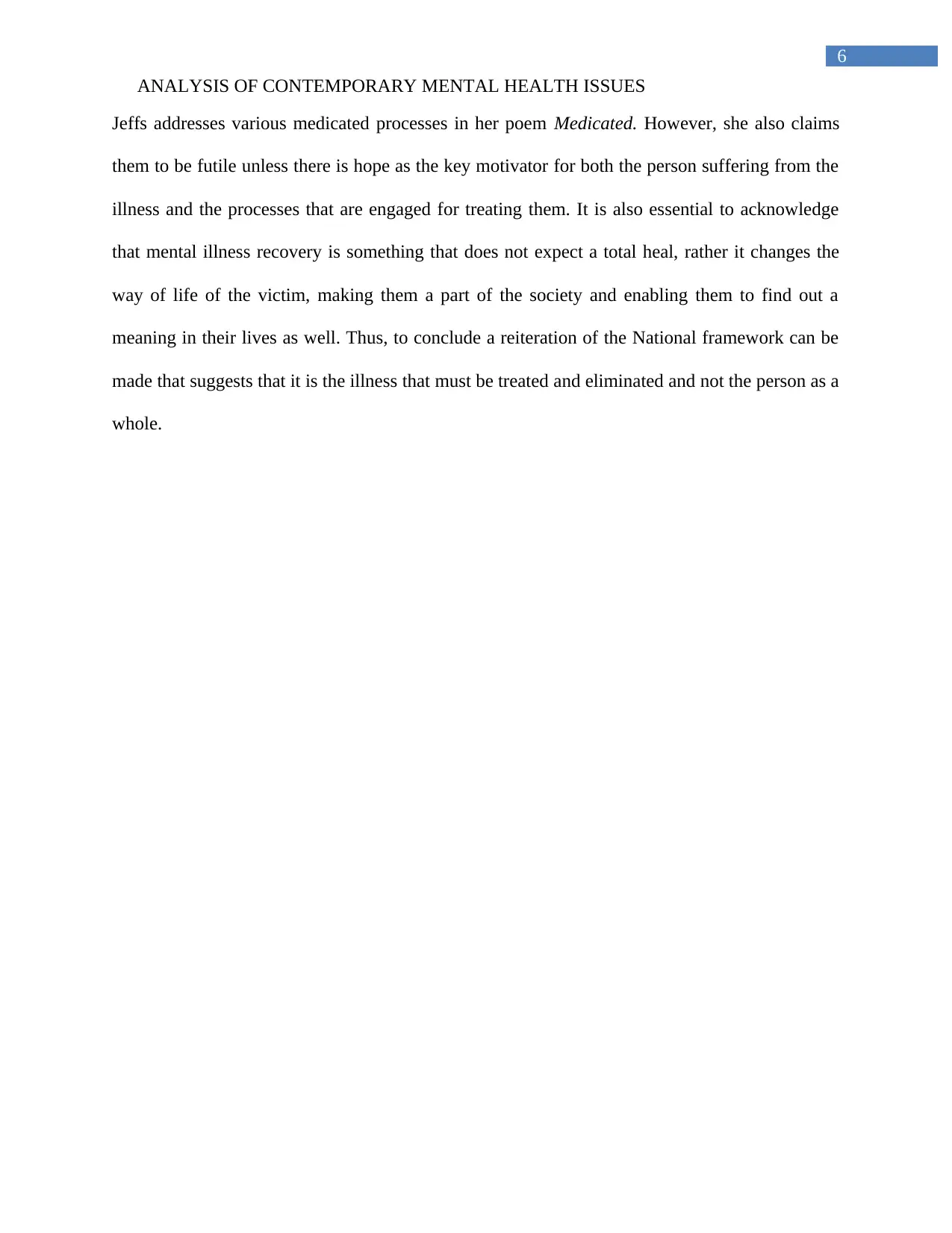
6
ANALYSIS OF CONTEMPORARY MENTAL HEALTH ISSUES
Jeffs addresses various medicated processes in her poem Medicated. However, she also claims
them to be futile unless there is hope as the key motivator for both the person suffering from the
illness and the processes that are engaged for treating them. It is also essential to acknowledge
that mental illness recovery is something that does not expect a total heal, rather it changes the
way of life of the victim, making them a part of the society and enabling them to find out a
meaning in their lives as well. Thus, to conclude a reiteration of the National framework can be
made that suggests that it is the illness that must be treated and eliminated and not the person as a
whole.
ANALYSIS OF CONTEMPORARY MENTAL HEALTH ISSUES
Jeffs addresses various medicated processes in her poem Medicated. However, she also claims
them to be futile unless there is hope as the key motivator for both the person suffering from the
illness and the processes that are engaged for treating them. It is also essential to acknowledge
that mental illness recovery is something that does not expect a total heal, rather it changes the
way of life of the victim, making them a part of the society and enabling them to find out a
meaning in their lives as well. Thus, to conclude a reiteration of the National framework can be
made that suggests that it is the illness that must be treated and eliminated and not the person as a
whole.
Paraphrase This Document
Need a fresh take? Get an instant paraphrase of this document with our AI Paraphraser
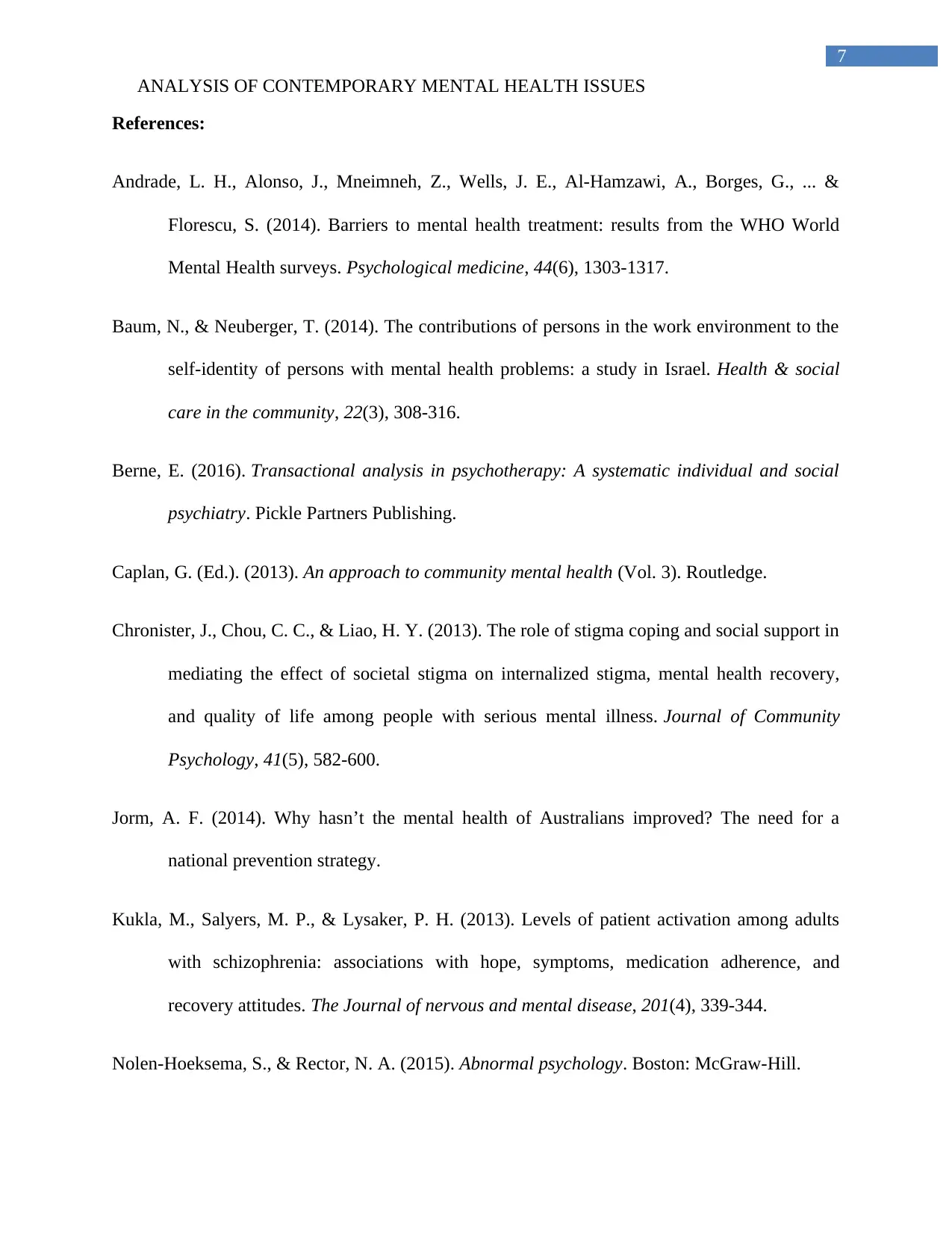
7
ANALYSIS OF CONTEMPORARY MENTAL HEALTH ISSUES
References:
Andrade, L. H., Alonso, J., Mneimneh, Z., Wells, J. E., Al-Hamzawi, A., Borges, G., ... &
Florescu, S. (2014). Barriers to mental health treatment: results from the WHO World
Mental Health surveys. Psychological medicine, 44(6), 1303-1317.
Baum, N., & Neuberger, T. (2014). The contributions of persons in the work environment to the
self‐identity of persons with mental health problems: a study in Israel. Health & social
care in the community, 22(3), 308-316.
Berne, E. (2016). Transactional analysis in psychotherapy: A systematic individual and social
psychiatry. Pickle Partners Publishing.
Caplan, G. (Ed.). (2013). An approach to community mental health (Vol. 3). Routledge.
Chronister, J., Chou, C. C., & Liao, H. Y. (2013). The role of stigma coping and social support in
mediating the effect of societal stigma on internalized stigma, mental health recovery,
and quality of life among people with serious mental illness. Journal of Community
Psychology, 41(5), 582-600.
Jorm, A. F. (2014). Why hasn’t the mental health of Australians improved? The need for a
national prevention strategy.
Kukla, M., Salyers, M. P., & Lysaker, P. H. (2013). Levels of patient activation among adults
with schizophrenia: associations with hope, symptoms, medication adherence, and
recovery attitudes. The Journal of nervous and mental disease, 201(4), 339-344.
Nolen-Hoeksema, S., & Rector, N. A. (2015). Abnormal psychology. Boston: McGraw-Hill.
ANALYSIS OF CONTEMPORARY MENTAL HEALTH ISSUES
References:
Andrade, L. H., Alonso, J., Mneimneh, Z., Wells, J. E., Al-Hamzawi, A., Borges, G., ... &
Florescu, S. (2014). Barriers to mental health treatment: results from the WHO World
Mental Health surveys. Psychological medicine, 44(6), 1303-1317.
Baum, N., & Neuberger, T. (2014). The contributions of persons in the work environment to the
self‐identity of persons with mental health problems: a study in Israel. Health & social
care in the community, 22(3), 308-316.
Berne, E. (2016). Transactional analysis in psychotherapy: A systematic individual and social
psychiatry. Pickle Partners Publishing.
Caplan, G. (Ed.). (2013). An approach to community mental health (Vol. 3). Routledge.
Chronister, J., Chou, C. C., & Liao, H. Y. (2013). The role of stigma coping and social support in
mediating the effect of societal stigma on internalized stigma, mental health recovery,
and quality of life among people with serious mental illness. Journal of Community
Psychology, 41(5), 582-600.
Jorm, A. F. (2014). Why hasn’t the mental health of Australians improved? The need for a
national prevention strategy.
Kukla, M., Salyers, M. P., & Lysaker, P. H. (2013). Levels of patient activation among adults
with schizophrenia: associations with hope, symptoms, medication adherence, and
recovery attitudes. The Journal of nervous and mental disease, 201(4), 339-344.
Nolen-Hoeksema, S., & Rector, N. A. (2015). Abnormal psychology. Boston: McGraw-Hill.
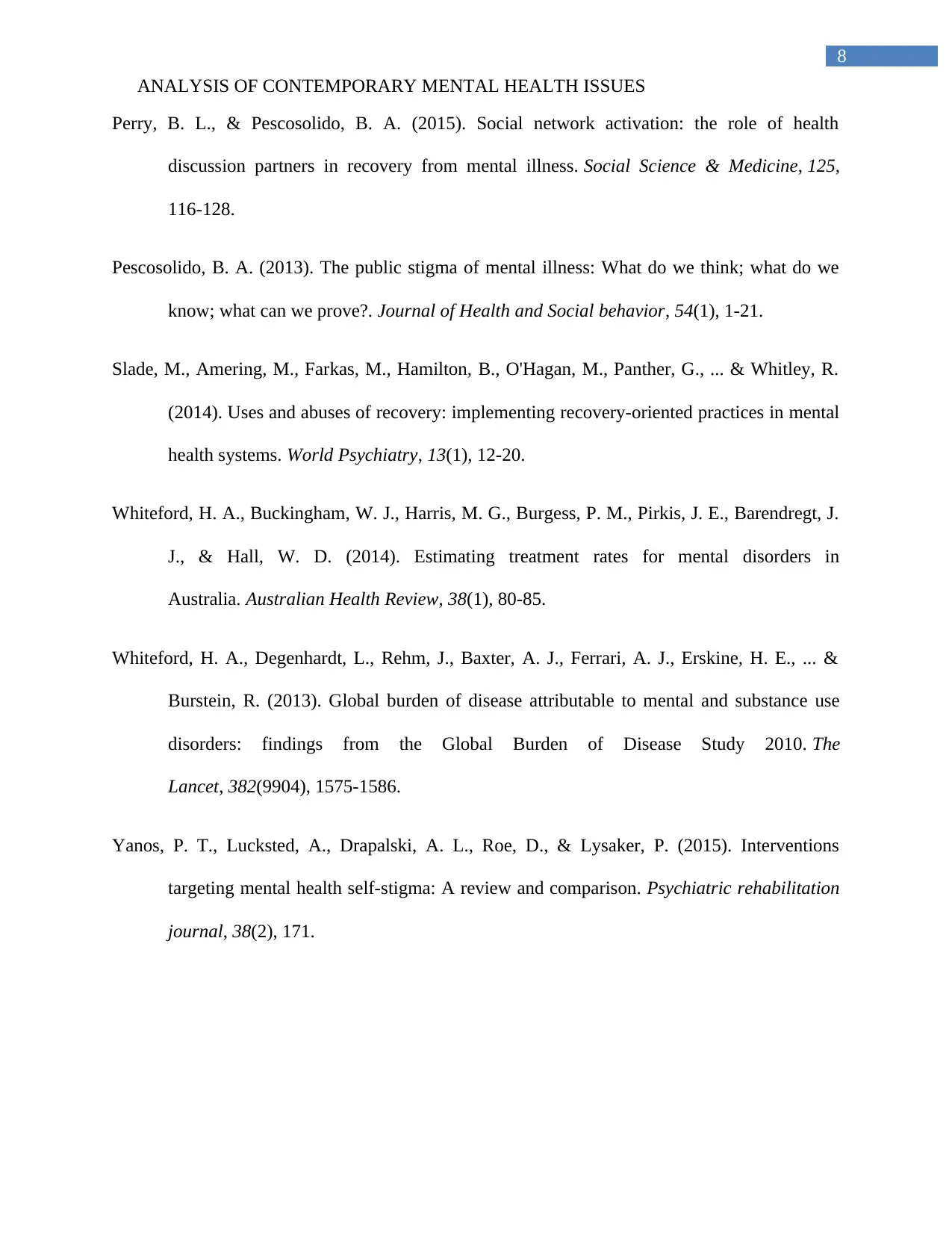
8
ANALYSIS OF CONTEMPORARY MENTAL HEALTH ISSUES
Perry, B. L., & Pescosolido, B. A. (2015). Social network activation: the role of health
discussion partners in recovery from mental illness. Social Science & Medicine, 125,
116-128.
Pescosolido, B. A. (2013). The public stigma of mental illness: What do we think; what do we
know; what can we prove?. Journal of Health and Social behavior, 54(1), 1-21.
Slade, M., Amering, M., Farkas, M., Hamilton, B., O'Hagan, M., Panther, G., ... & Whitley, R.
(2014). Uses and abuses of recovery: implementing recovery‐oriented practices in mental
health systems. World Psychiatry, 13(1), 12-20.
Whiteford, H. A., Buckingham, W. J., Harris, M. G., Burgess, P. M., Pirkis, J. E., Barendregt, J.
J., & Hall, W. D. (2014). Estimating treatment rates for mental disorders in
Australia. Australian Health Review, 38(1), 80-85.
Whiteford, H. A., Degenhardt, L., Rehm, J., Baxter, A. J., Ferrari, A. J., Erskine, H. E., ... &
Burstein, R. (2013). Global burden of disease attributable to mental and substance use
disorders: findings from the Global Burden of Disease Study 2010. The
Lancet, 382(9904), 1575-1586.
Yanos, P. T., Lucksted, A., Drapalski, A. L., Roe, D., & Lysaker, P. (2015). Interventions
targeting mental health self-stigma: A review and comparison. Psychiatric rehabilitation
journal, 38(2), 171.
ANALYSIS OF CONTEMPORARY MENTAL HEALTH ISSUES
Perry, B. L., & Pescosolido, B. A. (2015). Social network activation: the role of health
discussion partners in recovery from mental illness. Social Science & Medicine, 125,
116-128.
Pescosolido, B. A. (2013). The public stigma of mental illness: What do we think; what do we
know; what can we prove?. Journal of Health and Social behavior, 54(1), 1-21.
Slade, M., Amering, M., Farkas, M., Hamilton, B., O'Hagan, M., Panther, G., ... & Whitley, R.
(2014). Uses and abuses of recovery: implementing recovery‐oriented practices in mental
health systems. World Psychiatry, 13(1), 12-20.
Whiteford, H. A., Buckingham, W. J., Harris, M. G., Burgess, P. M., Pirkis, J. E., Barendregt, J.
J., & Hall, W. D. (2014). Estimating treatment rates for mental disorders in
Australia. Australian Health Review, 38(1), 80-85.
Whiteford, H. A., Degenhardt, L., Rehm, J., Baxter, A. J., Ferrari, A. J., Erskine, H. E., ... &
Burstein, R. (2013). Global burden of disease attributable to mental and substance use
disorders: findings from the Global Burden of Disease Study 2010. The
Lancet, 382(9904), 1575-1586.
Yanos, P. T., Lucksted, A., Drapalski, A. L., Roe, D., & Lysaker, P. (2015). Interventions
targeting mental health self-stigma: A review and comparison. Psychiatric rehabilitation
journal, 38(2), 171.
1 out of 9
Related Documents
Your All-in-One AI-Powered Toolkit for Academic Success.
+13062052269
info@desklib.com
Available 24*7 on WhatsApp / Email
![[object Object]](/_next/static/media/star-bottom.7253800d.svg)
Unlock your academic potential
© 2024 | Zucol Services PVT LTD | All rights reserved.




